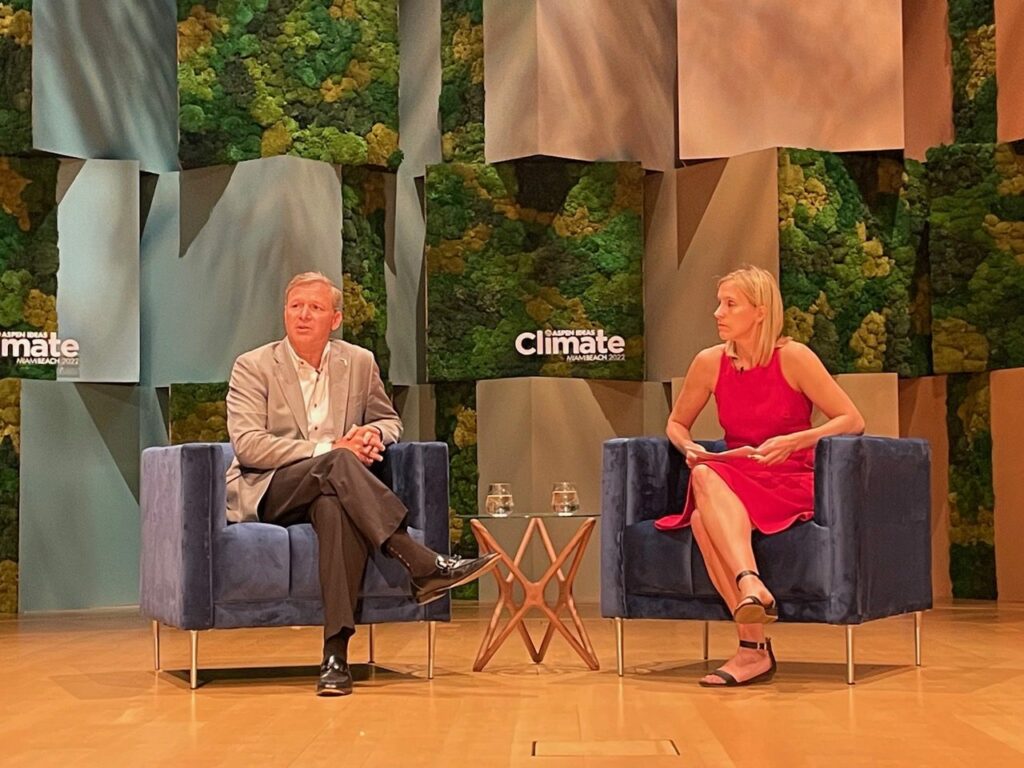By Riley Kaminer
Members of Congress, governors, technologists, researchers, consultants, and cadres of climate-concerned corporates all descended upon Miami Beach this week for the inaugural Aspen Ideas: Climate conference. Local leaders shared their thoughts on climate change with a global audience of 1,000 participants.
Tech featured prominently at the conference, set along the backdrop of Miami – one of America’s most vulnerable coastal areas. Here’s a rundown of the top four takeaways from this week’s conference.
1. Climate tech plays a central role in government’s plan to combat climate change.

From Representatives Wasserman Schultz and Frederica Wilson to Mayors Francis Suarez, Daniella Levine Cava, and Dan Gelber, South Florida’s government officials were out in full force at Aspen Ideas: Climate.
“Technology is driving this climate transformation,” said Miami Beach’s Gelber. “It’s technology that gives us the solutions and the options for responding to climate change.”
For the City of Miami’s Suarez, the key is not just adapting to climate change but reversing it. Technology plays a key role, he argued.
“Some of the carbon capture technology that I’ve seen just in the last year gives me a tremendous amount of hope for the innovative spirit of humanity to find ways to disrupt those very serious looking [climate change progression] curves,” said Suarez.
Ground zero for many of these technologies is Port Miami, where the county has invested in shore power infrastructure – the first of its kind in the US – which would let ships to connect to the local electric grid while in port. That’s a big deal because it would enable cruise ships to avoid expending fuel during the 15-20% of their lifespan spent docked in a port.
In a conversation held at Port Miami with five cruise line CEOs, Miami-Dade’s Levine Cava noted that this innovation will not be a panacea. “It is just one of the many things we can do to move towards net zero carbon impact,” she said. “It is certainly a giant step forward, but we’re not stopping here. There’s a lot more to be done.”
“When the industry works together, we can do amazing things,” added Rick Sasso, Chairman of MSC Cruises USA, emphasizing that much of this innovation happens through industry-wide actions.

2. Miami-Dade launched three new climate tech initiatives.
“Our goal is to make Miami-Dade the best place to build, test, and scale innovative solutions to major climate challenges,” commented Miami-Dade County Mayor Daniella Levine Cava. “Innovators and entrepreneurs are stepping up to tackle climate and resilience challenges and we welcome their initiatives.”
“Through these public-private partnerships, we are leveraging tech solutions and innovation to build a stronger, more resilient Miami-Dade – while investing in the jobs of the future,” she continued.
Levine Cava used the background of the port to announce a handful of new climate tech initiatives.
First, she announced a four-month pilot program with Austin-based startup Olea Edge to deploy AI-powered technology to locate meters that undercharge large commercial and industrial users. Levine Cava noted that this program has the potential to save the county millions of taxpayer dollars, while also conserving water.
The second initiative announced was a partnership with Bahamas-based accelerator Blue Action Lab and British accelerator and venture studio Founders Factory. The goal is to attract climate tech startups looking to prototype, test, and deploy their solutions in Biscayne Bay. Blue Action Lab hopes to raise $10 million to support 30 early-stage and 12 high-growth companies, selected in collaboration with the county.
The third initiative from Levine Cava was naming bluetech venture studio Seaworthy Collective Miami-Dade’s first startup in residence.
“Being headquartered at Mayor Levine Cava’s office allows us to connect innovators with policy makers, lowering barriers to implementation and catalyzing collaboration that previously would be siloed,” Seaworthy Collective’s founder and CEO, Daniel Kleinman, told Refresh Miami.
“This allows Seaworthy to expand on our community building foundations to help drive the future of the evolving Miami ocean and climate impact technology ecosystem,” Kleinman continued. “We look forward to expanding our engagement of local stakeholders to help empower the South Florida community to pursue their passions for impact through the opportunities we’ll be developing with the help and support of Mayor Levine Cava.”
3. Patience is a virtue: Much of the most exciting climate tech is early stage.
Nine global companies presented their solutions in a tech startup showcase during the conference. Close to home, Anya Freeman [pictured at top of this post] of Miami startup Living Seawalls (formerly the Addition Company) outlined her plan to 3D print seawalls that both protect shorelines and improve water quality.
A bit further south in Jamaica, Nicholas Kee of Kee Farms [pictured below] outlined his plans to use seaweed and oysters to capture carbon dioxide from the atmosphere. Kee, alongside Freeman, were both part of Seaworthy Collective’s first cohort.

Silicon Valley startup GoPowerEV also presented at the showcase. Founder John Reister, a serial entrepreneur with three successful exits under his belt, shared his solution to bring EV charging to multi-family homes.
While most EV charging companies deploy one or two bulky commercial charging units in parking lots, GoPowerEV’s vision is to deploy compact units in every space. That’s possible thanks to their turnkey charging solution, which is expected to cost 70% less than the legacy alternative. This is a particularly relevant innovation for Florida, the U.S. state with the second-highest number of electric vehicles (or 14th per capita).
“The rubber needs to be hitting the road,” Reister told Refresh Miami, emphasizing the immediate need for climate tech solutions. “This event has brought together a motivated, passionate community, including people that have the practical ability to solve the problems we’re facing. I’ve been really impressed by the conference and the great pool of people working to tackle these climate issues.”
4. Some of America’s biggest companies are using tech to tackle climate change, in Miami and beyond.
FPL had a major presence at the conference. CEO Eric Silagy discussed a range of tech-powered initiatives the company is undertaking to provide more sustainable energy options to Floridians. Expanding the use of solar panels is top of mind for FPL, despite supply chain issues slowing down their deployment across the state.
Alongside solar, batteries are a major focus. “We just commissioned the world’s largest battery storage facility powered by a solar facility,” Silagy [pictured below] said of a 40-acre battery in Manatee County.

AT&T’s Head of Global Environmental Sustainability, Shannon Carroll, also attended and spoke at the conference. In an interview with Refresh Miami, Carroll asserted that the telecom provider’s climate strategy includes a goal to develop solutions that help business customers collectively reduce a gigaton of greenhouse gas emissions by 2035.
The company has made a major push to collect and share climate data. “We’re democratizing access to this climate data in a way that doesn’t currently exist,” he said.
Why is access to this data important? “We need all the communities we serve to be climate resistant,” asserted Carroll. “Our total value chain has to be climate resistant.”
Have FOMO? Don’t worry, Aspen Ideas has committed to hosting this conference in Miami Beach for the next two years at least.
READ MORE ON REFRESH MIAMI:
- 3D-printed seawalls may be coming soon to a beach near you, thanks to this Miami startup
- Catching up with Seaworthy Collective as it sets sail with venture studio
- EndeavorLAB announces its cleantech and climatetech cohort. Let’s meet them.
- OBE Power is plugging Miami into the EV revolution
- AI, climatetech and healthtech reign supreme on Day 1 of eMerge Americas’ 10th anniversary - April 18, 2024
- Brought together by tech, kept together by culture: Miami’s protagonistic role in LatAm’s startup story - April 15, 2024
- New World Angels launches Innovation Fund to write pre-seed checks - April 12, 2024





